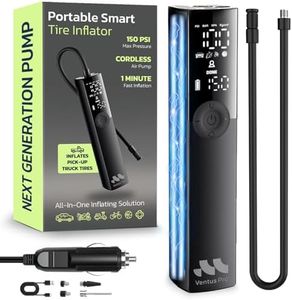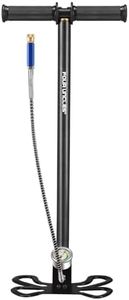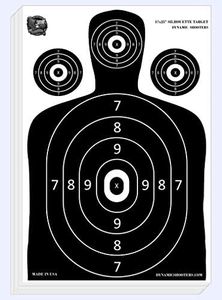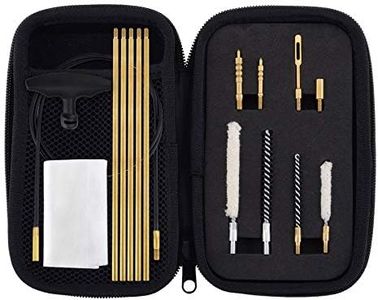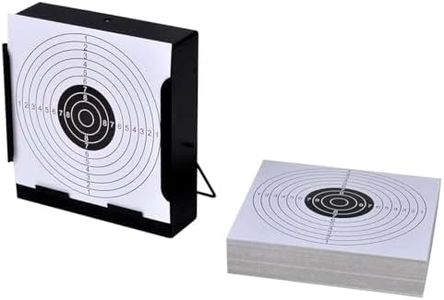We Use CookiesWe use cookies to enhance the security, performance,
functionality and for analytical and promotional activities. By continuing to browse this site you
are agreeing to our privacy policy
8 Best Pellet Air Rifles
From leading brands and best sellers available on the web.Buying Guide for the Best Pellet Air Rifles
When choosing a pellet air rifle, it's important to understand your primary use case—are you interested in target shooting, hunting small game, or backyard plinking? Focusing on your intended use helps you navigate the many options available, each with different power levels, sizes, and features. The right pellet air rifle should be comfortable to hold, easy to operate, and matched to your shooting goals; carefully considering the main specifications will help you avoid frustration and make the most of your shooting experience.CaliberCaliber refers to the diameter of the pellet that the air rifle shoots, commonly measured in inches or millimeters. The most common calibers for pellet air rifles are .177 (4.5mm) and .22 (5.5mm). This is important because pellet size affects velocity, energy, and accuracy. .177 calibers are well-suited for target shooting and plinking due to their higher velocity and flatter trajectory, making them more precise over longer distances with less pellet drop. .22 calibers deliver more energy, making them better for hunting small game. To pick the right caliber, think about whether your focus is on tight groups in paper targets or on taking down pests and small animals.
Power SourceA pellet air rifle can be powered in different ways: spring-piston, gas piston, or pre-charged pneumatic (PCP). This spec determines how the gun is cocked and how it propels the pellet. Spring-piston and gas piston rifles need to be cocked for each shot, offering convenience and simplicity but with some recoil and noise. PCP rifles, on the other hand, use compressed air and give multiple shots per fill with less recoil and a smoother shot, which is great for accuracy. Pick a power system based on whether you value convenience, power consistency, ease of maintenance, or a quiet, recoilless shooting experience.
VelocityVelocity is the speed at which the pellet leaves the barrel, measured in feet per second (FPS) or meters per second (MPS). Higher velocities are better for distance and hunting, but can sometimes reduce accuracy because the pellet gets more unstable. Common velocities range from around 500 FPS to over 1200 FPS. Lower velocities (under 800 FPS) are quieter and suitable for target shooting, medium velocities (800-1000 FPS) offer a good balance for most uses, while high velocities (above 1000 FPS) are best for hunting or long-range targets. Choose a velocity range that fits your main activities—accuracy for target shooting or power for hunting.
AccuracyAccuracy describes how consistently the air rifle can hit the same spot at a given distance. Factors influencing accuracy include the quality of the barrel, sights or optics, trigger design, and even the stock's fit. Pellet air rifles with rifled barrels and good quality sights will shoot more accurately, especially at longer distances. If your goal is precise target shooting, prioritize models with features that enhance accuracy—look for adjustable triggers and compatibility with scopes, and make sure the gun feels balanced in your hands. If plinking or informal shooting is your priority, moderate accuracy is acceptable.
Noise LevelNoise level refers to how loud the rifle is when fired. Some pellet air rifles are engineered to be very quiet, while others can be surprisingly loud, especially powerful break-barrel types. This is important if you’ll be shooting in a backyard or populated areas and want to avoid disturbing neighbors. Low-velocity rifles and PCPs with built-in suppressors tend to be much quieter. Consider the setting where you plan to shoot; if noise matters, seek out models specifically described as quiet or backyard-friendly.
Weight and ErgonomicsWeight and ergonomics refer to how heavy the rifle is and how comfortable it is to hold and shoot. Heavier rifles offer more stability, which can help with accurate shooting, but they're harder to carry over long distances or for younger shooters. Lighter air rifles are easier to manage but may be less stable. Ergonomic designs with adjustable stocks and comfortable grips can make shooting more enjoyable, particularly during longer sessions. Consider your own strength, who will use the rifle, and how you'll use it to determine the best balance of weight and comfort.
Magazine Capacity and ReloadingSome pellet air rifles are single-shot, requiring you to load one pellet at a time, while others include magazines that hold multiple pellets for quicker follow-up shots. This specification affects your shooting experience—magazines are convenient for hunting or target sessions where quick shots are needed, while single-shots can teach patience and focus and are simpler in design. Choose based on whether you value rapid-fire capability or simplicity and reliability.
